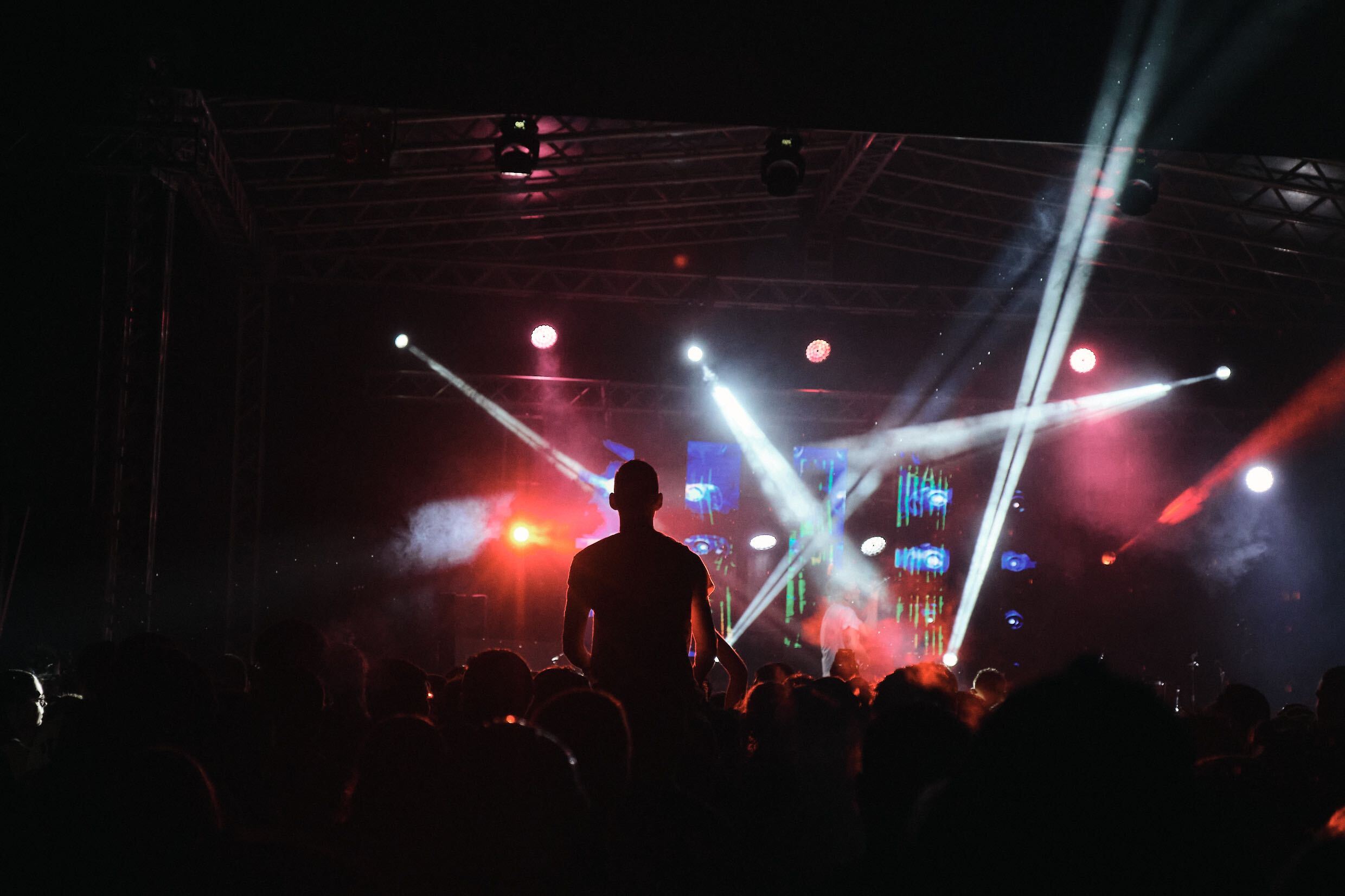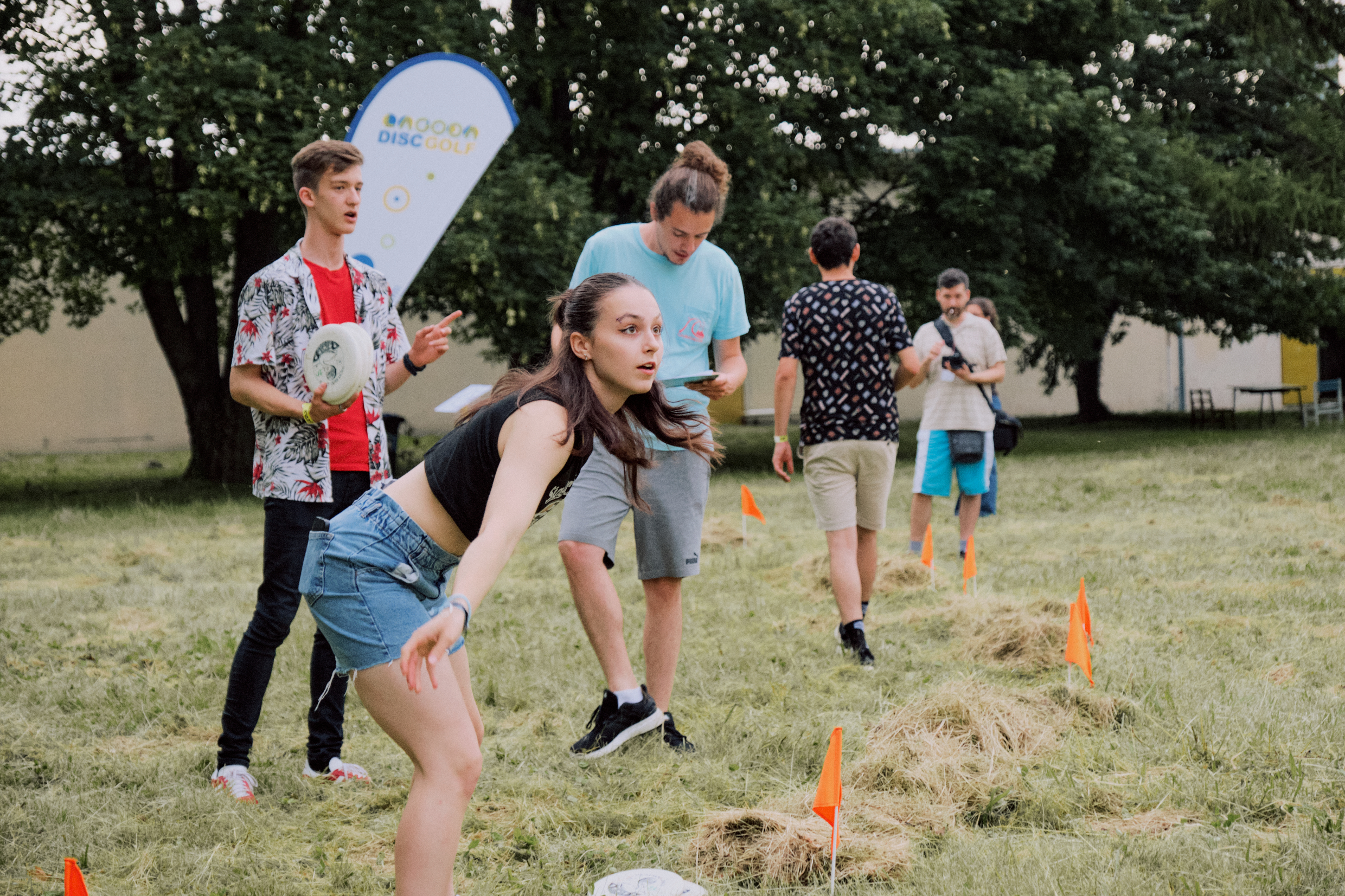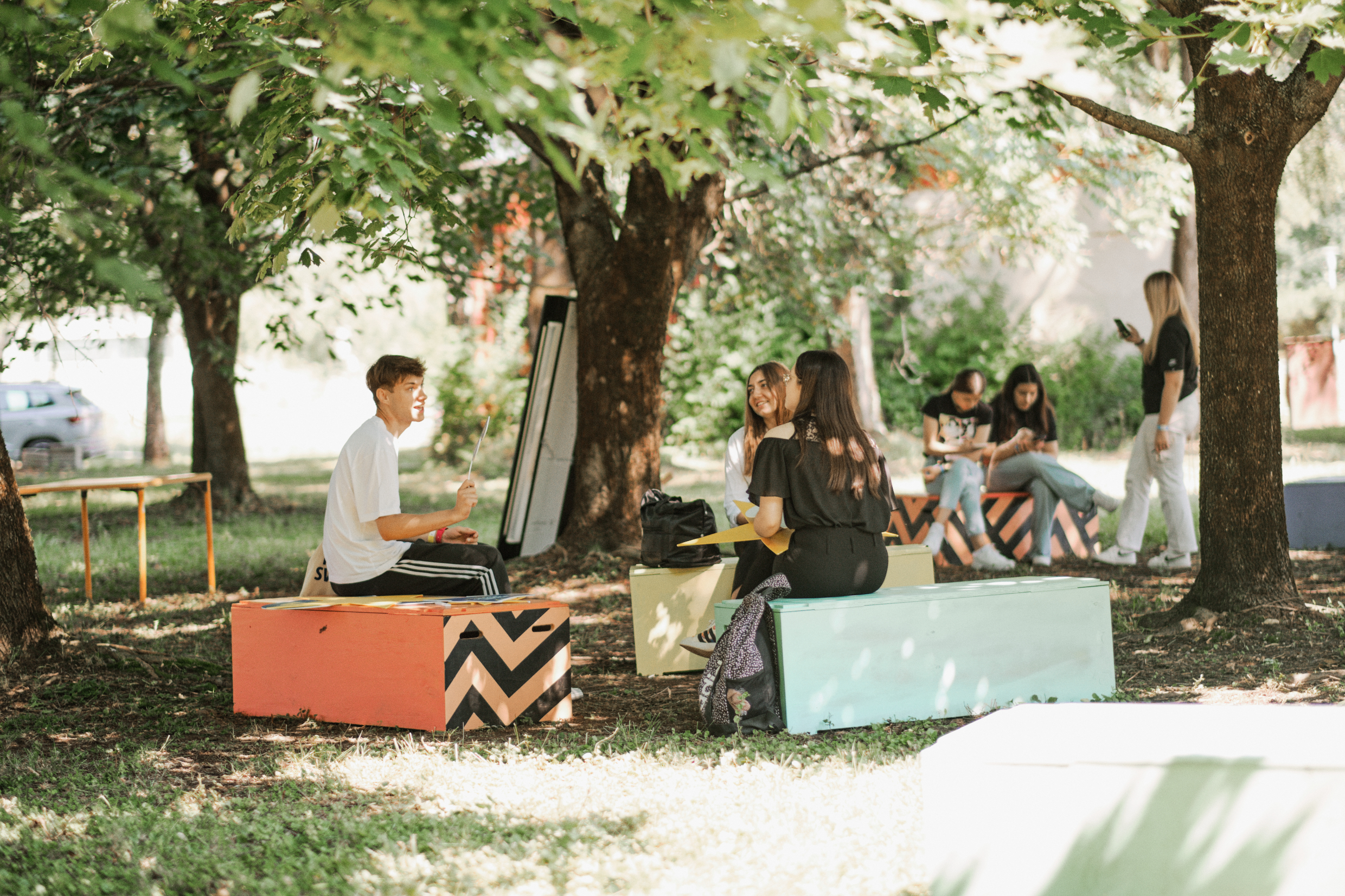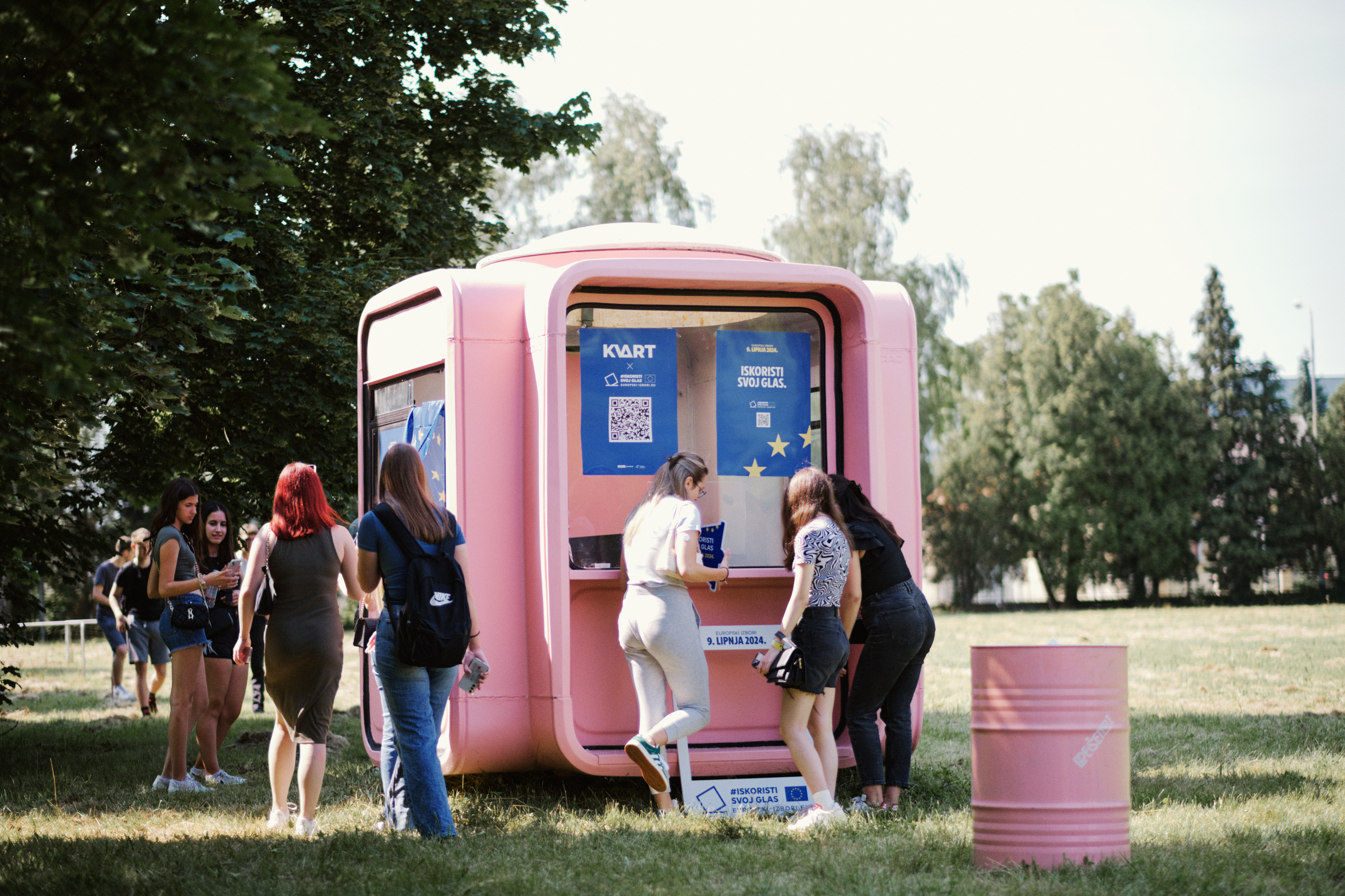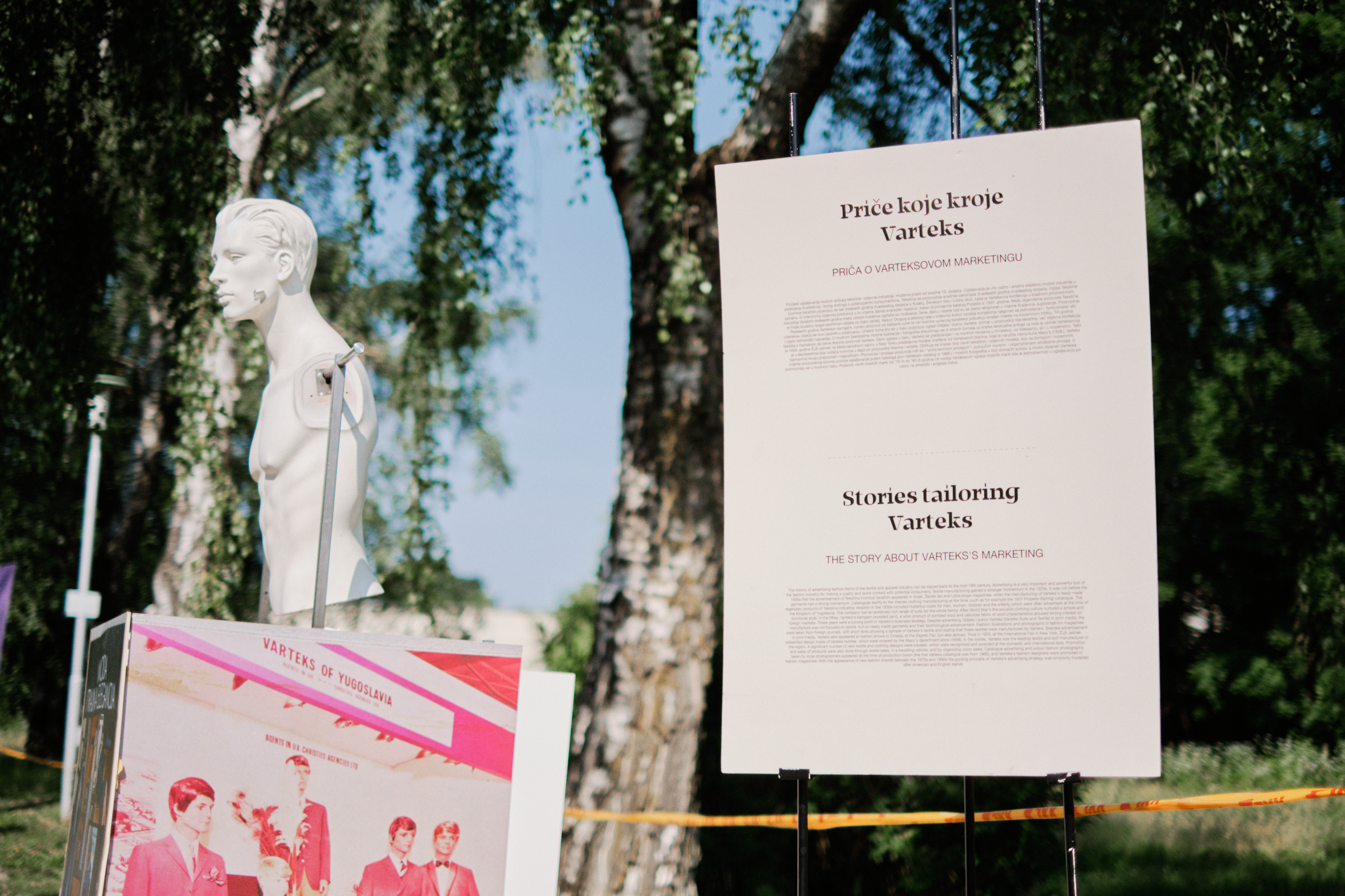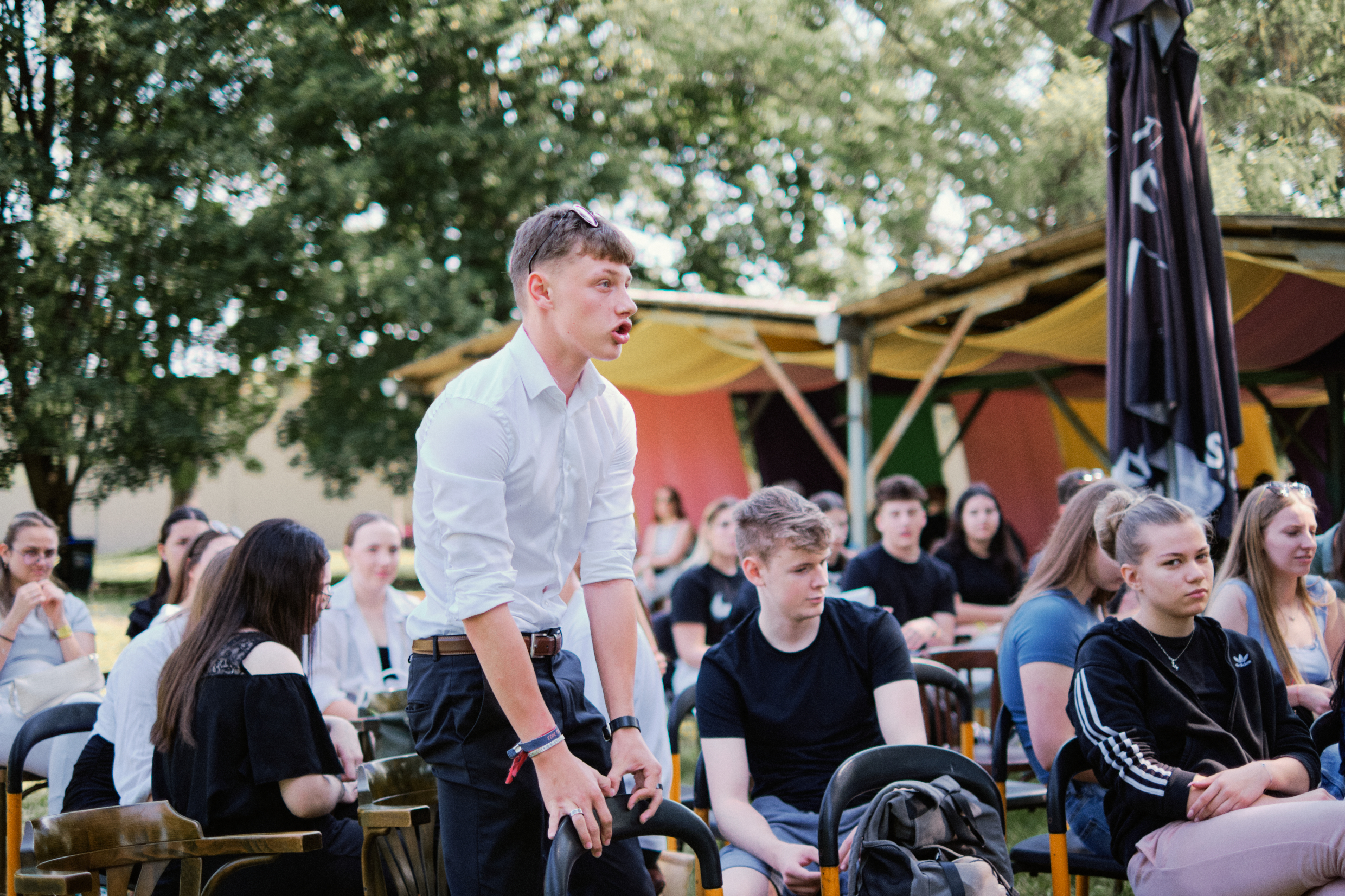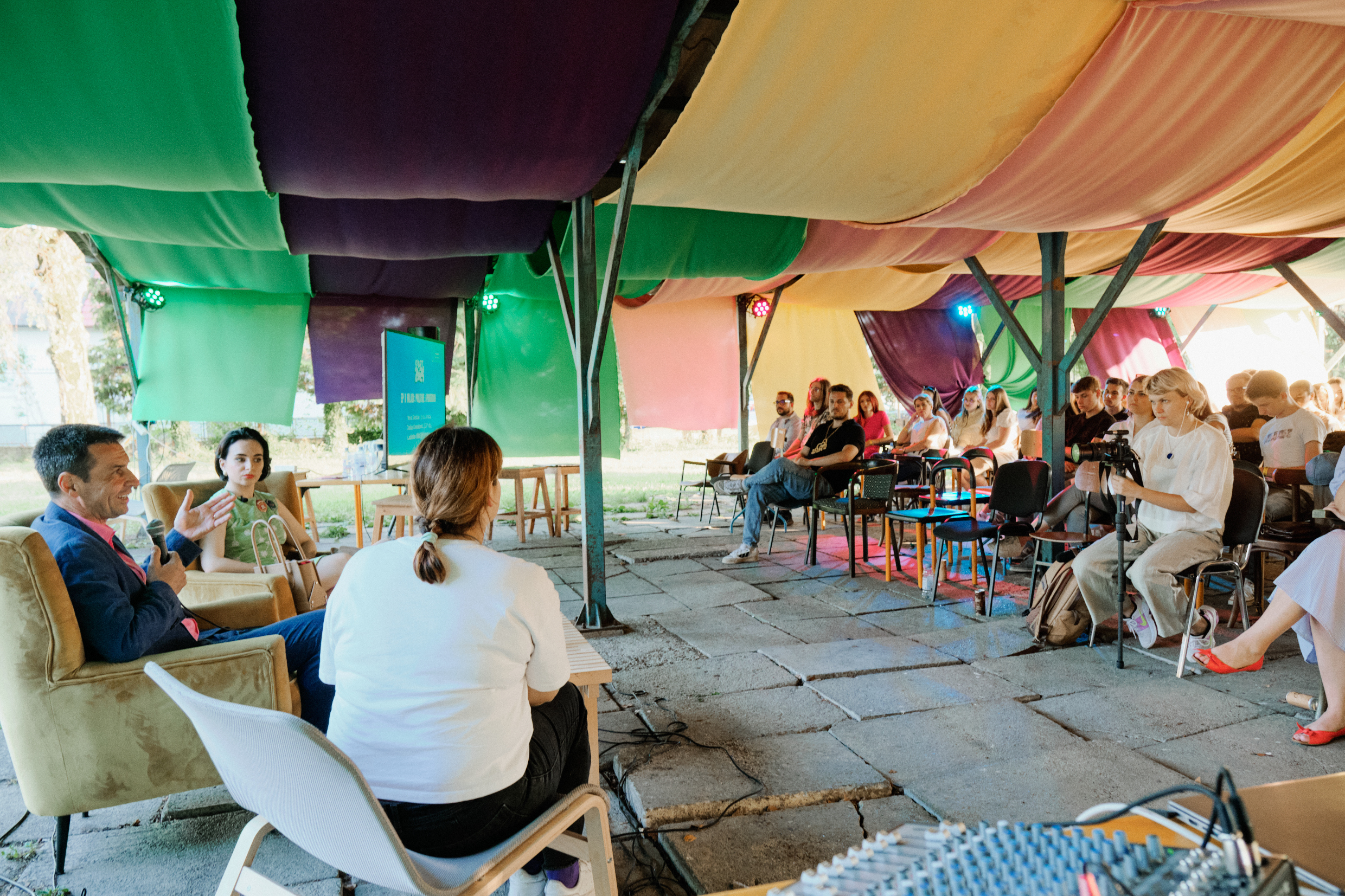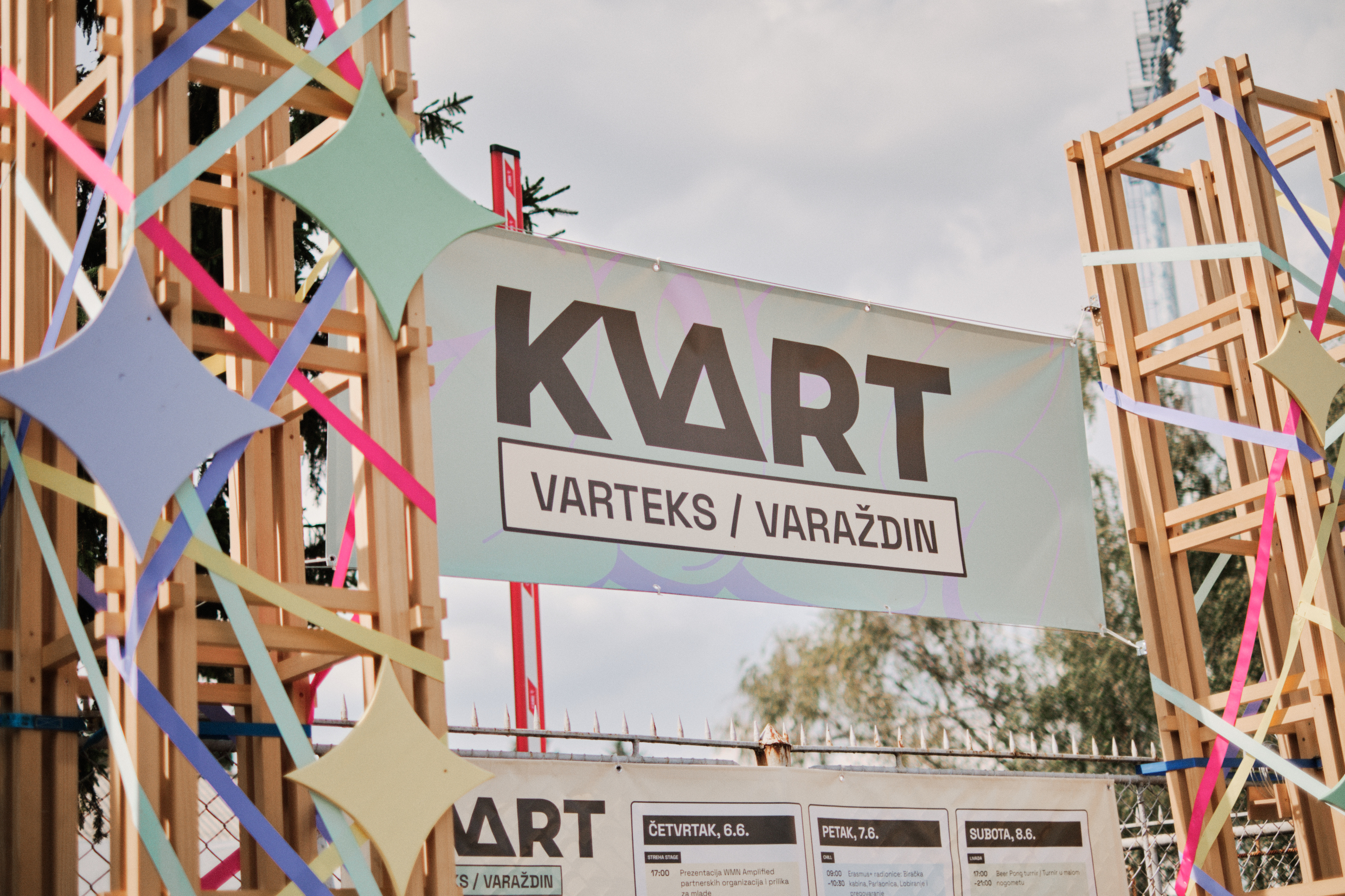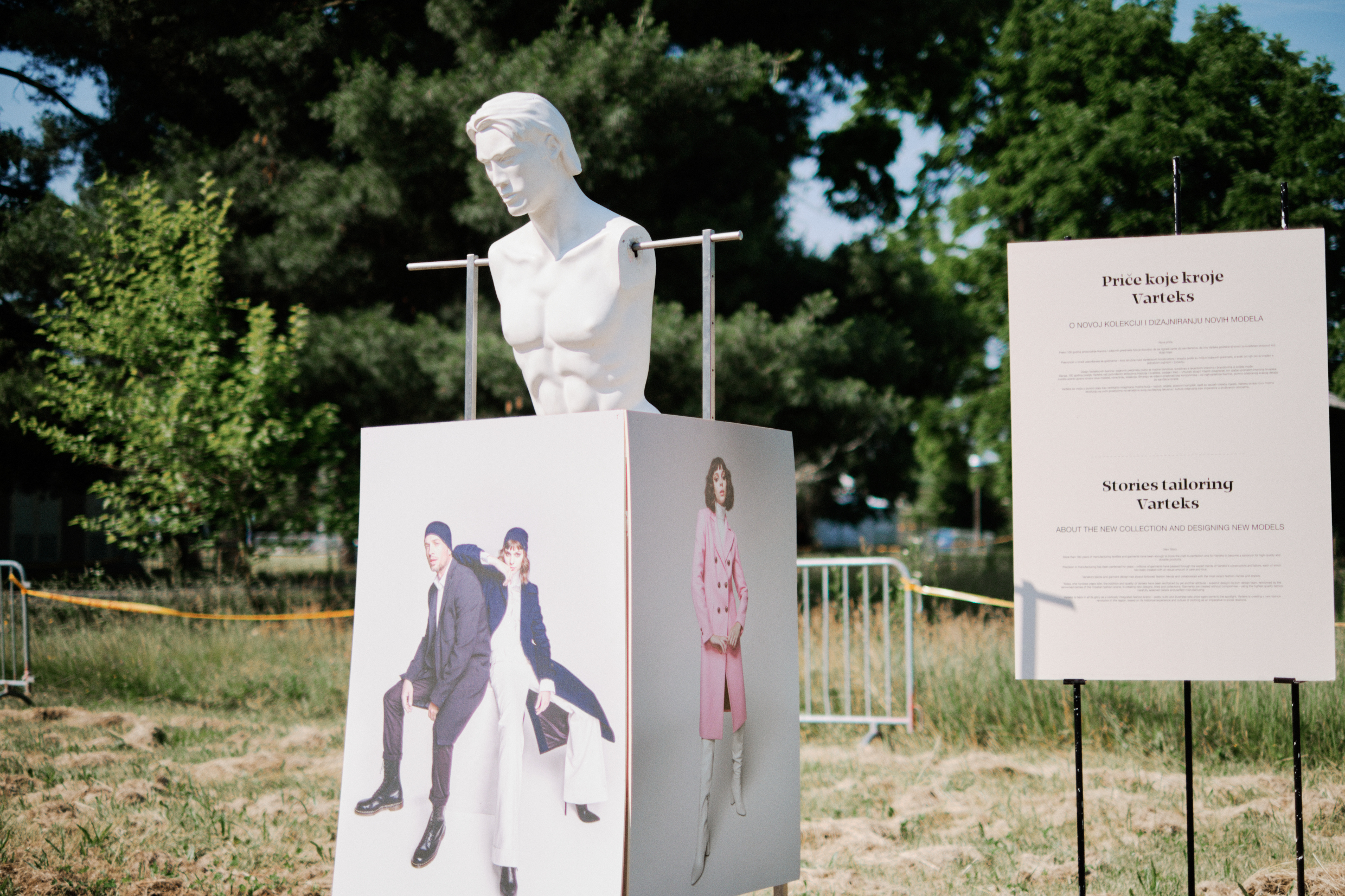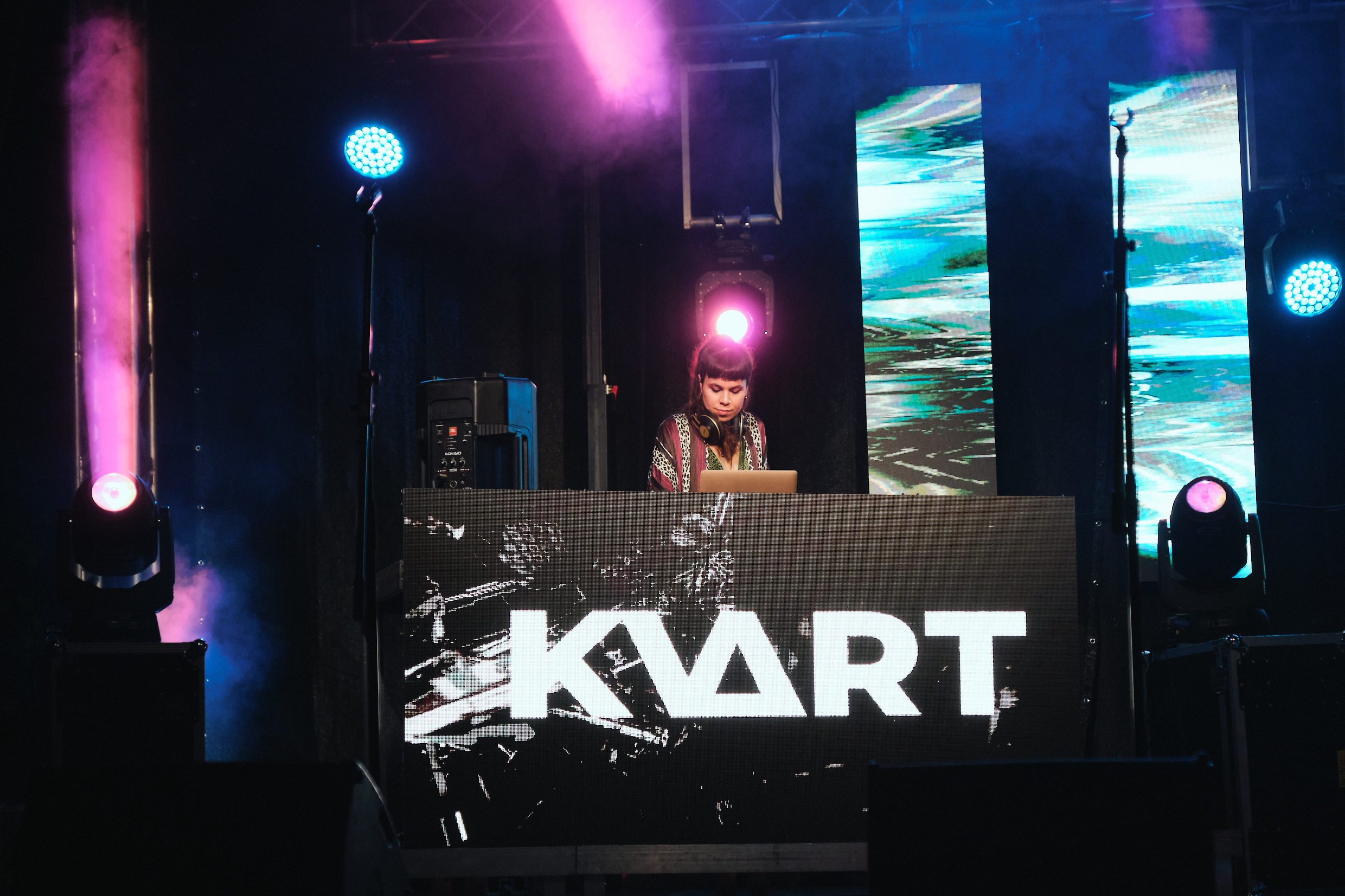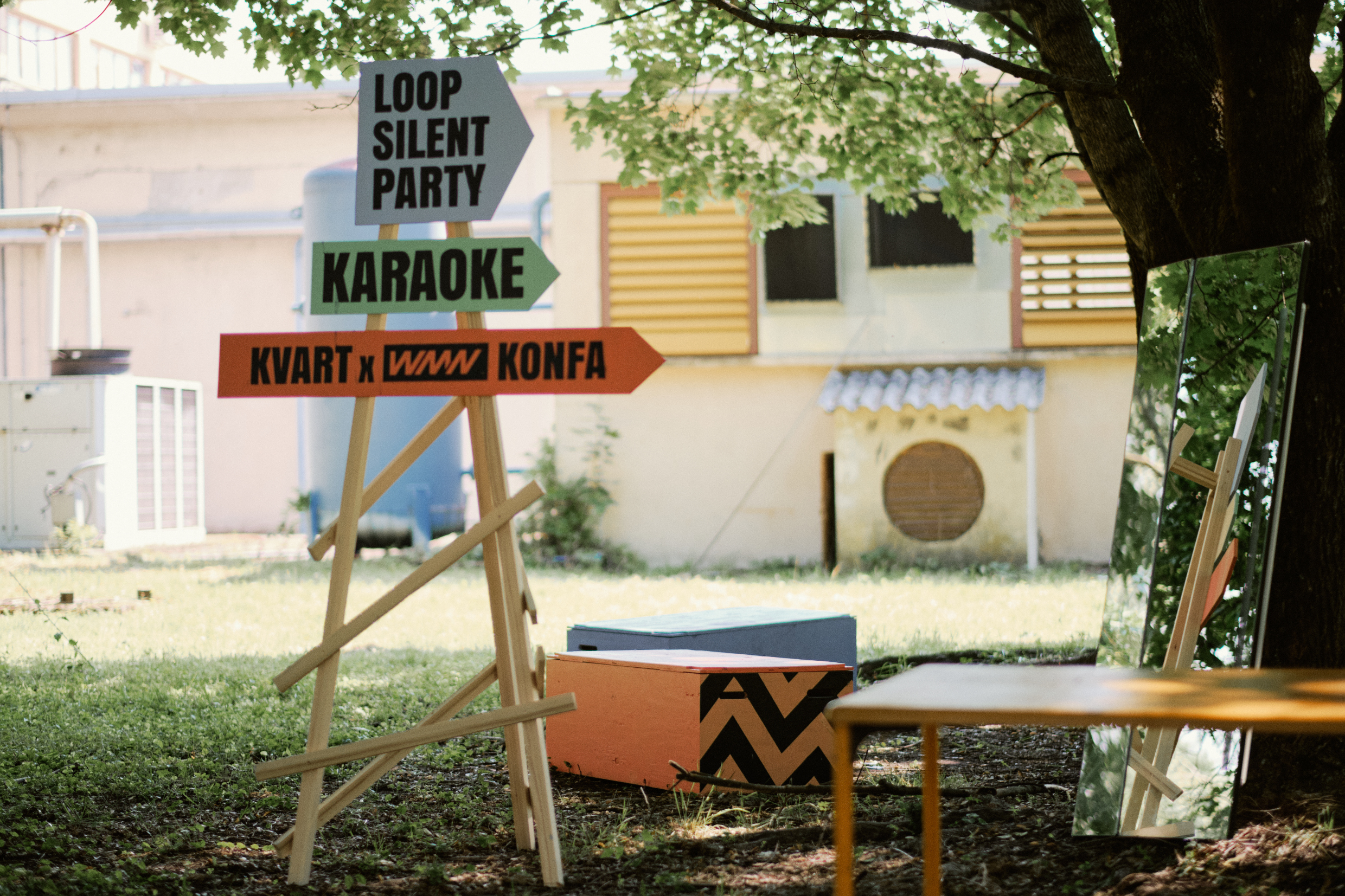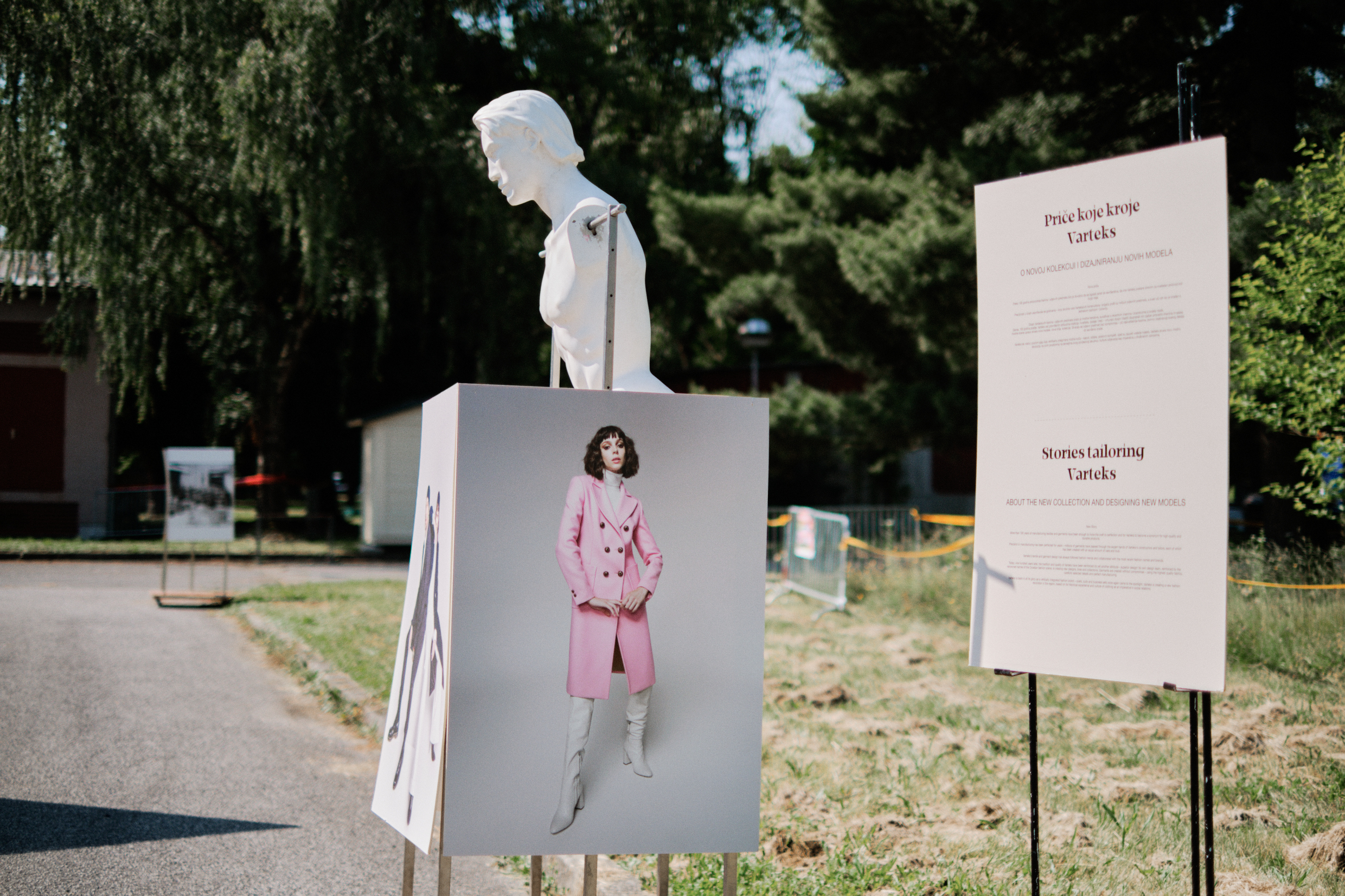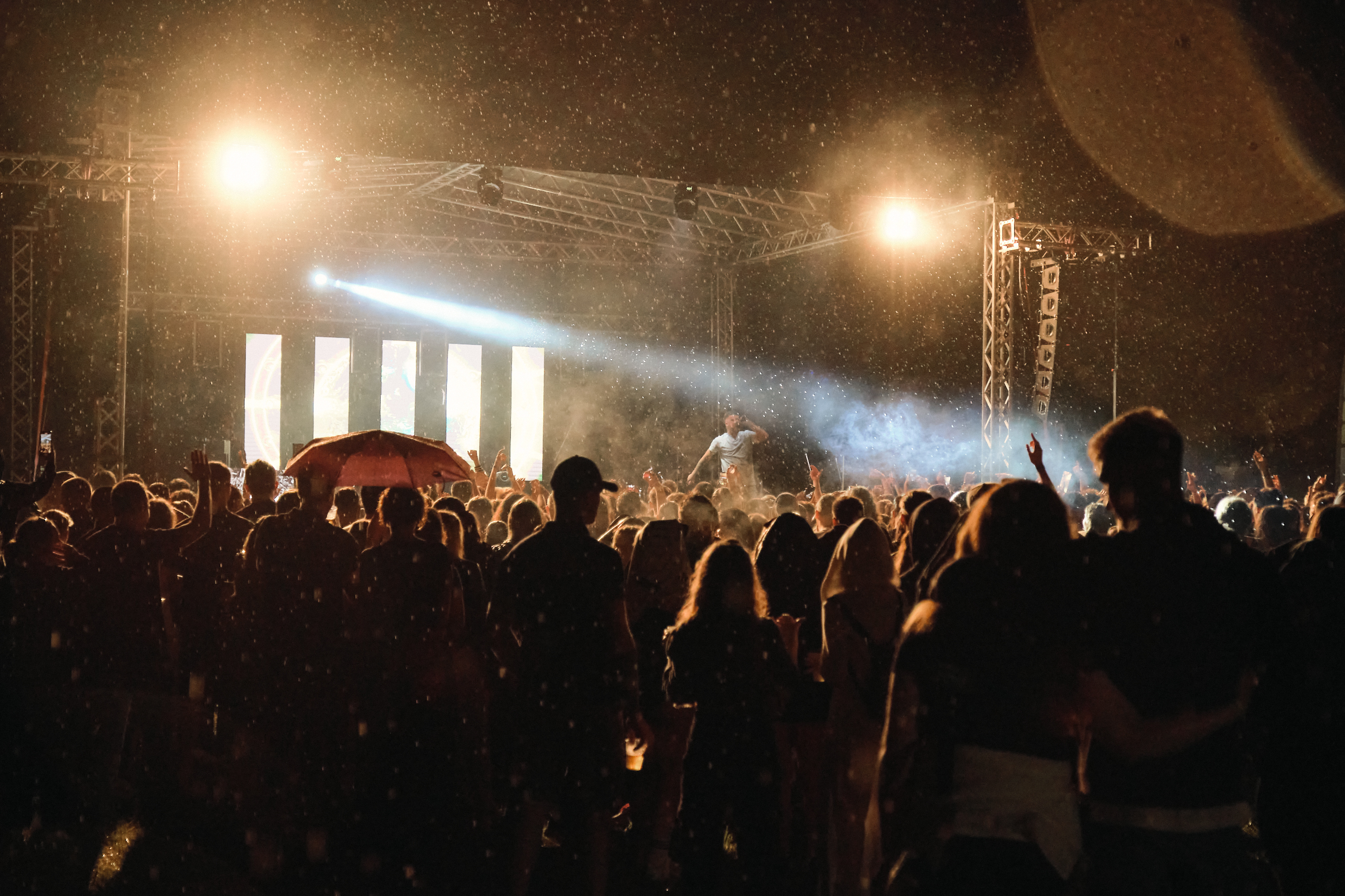Regaining a sense of belonging
KVART
KVART: A community music festival transforming an abandoned industrial complex into a neighborhood.
KVART (eng. neighborhood) is a music and community festival that is redefining the abandoned textile factory and its surroundings into a new meeting point and potential neighborhood. Led by young locals together with their broad network of local community, private sector and decision makers.
The fusion of cultural expression transforms the once-forgotten space into a dynamic, living environment and demonstrates how an abandoned space can evolve into a vibrant area driven by collective memory.
The fusion of cultural expression transforms the once-forgotten space into a dynamic, living environment and demonstrates how an abandoned space can evolve into a vibrant area driven by collective memory.
Croatia
National
Mainly urban
It refers to other types of transformations (soft investment)
Yes
2024-09-01
Yes
ERASMUS
No
No
As a representative of an organisation
For us, locals, the importance of culture, the textile and fashion industry is coming from the rich industrial legacy of Varteks - once serving as a textile giant that played a significant role in the international fashion industry. For decades, Varteks was a cornerstone of local economic and cultural identity designing high-quality garments for globally renowned brands such as Hugo Boss and Levi’s.
Beyond its economic impact, the factory was also a symbol of industrial progress and community livelihood, providing employment for generations and shaping the city’s identity as a hub of textile excellence. However, it faced decline due to shifting global economic trends, leading to its eventual abandonment.
KVART seeks to reclaim this legacy, not by mourning what was lost, but by reimagining the factory’s role in contemporary culture. By integrating music, fashion, and community-driven initiatives, the festival honors the site’s history while transforming it into a new space for creativity, collaboration, and future possibilities.
That is why the main objective of KVART is to revitalise the Varteks industrial complex into a place that encourages a social, cultural and green transformation in the long run, while having in mind the senses, emotions and needs of a local community.
Specific objectives:
To reduce the environmental impacts (sustainable practices and eco-friendly solutions for the reimagining of the abandoned factory)
To enable a creative re-invention of the abandoned factory
To foster inclusion across multiple dimensions ensuring accessibility, affordability, and equal treatment for all
To enrich the local community and its members through innovative ideas
To reach a transformational impact by vertical connections
To integrate an interdisciplinary approach towards reaching the main goal
Target groups in this project include the local community, young people, artists and creative professionals, decision makers and wider public
Beyond its economic impact, the factory was also a symbol of industrial progress and community livelihood, providing employment for generations and shaping the city’s identity as a hub of textile excellence. However, it faced decline due to shifting global economic trends, leading to its eventual abandonment.
KVART seeks to reclaim this legacy, not by mourning what was lost, but by reimagining the factory’s role in contemporary culture. By integrating music, fashion, and community-driven initiatives, the festival honors the site’s history while transforming it into a new space for creativity, collaboration, and future possibilities.
That is why the main objective of KVART is to revitalise the Varteks industrial complex into a place that encourages a social, cultural and green transformation in the long run, while having in mind the senses, emotions and needs of a local community.
Specific objectives:
To reduce the environmental impacts (sustainable practices and eco-friendly solutions for the reimagining of the abandoned factory)
To enable a creative re-invention of the abandoned factory
To foster inclusion across multiple dimensions ensuring accessibility, affordability, and equal treatment for all
To enrich the local community and its members through innovative ideas
To reach a transformational impact by vertical connections
To integrate an interdisciplinary approach towards reaching the main goal
Target groups in this project include the local community, young people, artists and creative professionals, decision makers and wider public
industrial heritage
community
neighbourhood
music
fashion
Specific objective #1
In order to reduce the harmful impact on the environment we use promotional materials that were made of sustainable materials, we use digital materials and avoid excessive throwing of these materials in the bin, and use reusable plastic instead of single use plastic (e.g. reusable cups).
Our exterior designers use sustainable materials (with the focus on wood) that are then recycled for the creation of elements for either other projects or other elements for KVART. The creation of those elements is also done in a way that the elements can be used for other purposes (e.g. wooden benches are also used for storage etc.).
Additionally, involvement of volunteer sections that are dedicated to reducing the environmental impact of the project contributes to the sense of belonging and responsibility of each of the individuals involved inside the community. They encourage the separation of waste and place bins for recycling, set mobile ashtrays and assist in carefully ordering food.
Travel arrangements are done in partnership with the Croatian Railways (HŽ) to ensure that “green travel” options are both available and affordable. Discounted travel arrangements enable participants from other Croatian towns and cities (particularly young people) to participate in the project.
All in all, this focus on environmental sustainability aligns with the broader goal of creating socially responsible models for future festivals and activities. The activities to reach the set objective in terms of sustainability are also in accordance with the goals of the European Green Deal by challenging climate change.
Because of the project’s transformative nature, the community is encouraged not only to act to prevent pollution and garbage accumulation, but to consider creative solutions that could be used in the long run when the transformation is completed.
In order to reduce the harmful impact on the environment we use promotional materials that were made of sustainable materials, we use digital materials and avoid excessive throwing of these materials in the bin, and use reusable plastic instead of single use plastic (e.g. reusable cups).
Our exterior designers use sustainable materials (with the focus on wood) that are then recycled for the creation of elements for either other projects or other elements for KVART. The creation of those elements is also done in a way that the elements can be used for other purposes (e.g. wooden benches are also used for storage etc.).
Additionally, involvement of volunteer sections that are dedicated to reducing the environmental impact of the project contributes to the sense of belonging and responsibility of each of the individuals involved inside the community. They encourage the separation of waste and place bins for recycling, set mobile ashtrays and assist in carefully ordering food.
Travel arrangements are done in partnership with the Croatian Railways (HŽ) to ensure that “green travel” options are both available and affordable. Discounted travel arrangements enable participants from other Croatian towns and cities (particularly young people) to participate in the project.
All in all, this focus on environmental sustainability aligns with the broader goal of creating socially responsible models for future festivals and activities. The activities to reach the set objective in terms of sustainability are also in accordance with the goals of the European Green Deal by challenging climate change.
Because of the project’s transformative nature, the community is encouraged not only to act to prevent pollution and garbage accumulation, but to consider creative solutions that could be used in the long run when the transformation is completed.
Specific objective #2
When we started planning the KVART setup at the new venue - Varteks - every detail had to be carefully designed. Such a careful approach was crucial in reaching into the hearts and minds of the community who has a “soft spot” for the fallen textile and fashion industry giant in which thousands of people provided for their families for generations.
The visual identity is crucial in connecting all parts of KVART, from promotion and all preparatory activities to the actual execution on the ground. It builds a clear and strong visual message, helps create an emotional connection, and becomes a symbol of the experience that visitors have gained and will gain in the future.
It is also an investment in community development for generations to come. Only by reaching into their senses and emotions on top of their needs will we stand a chance in integrating new social and cultural values while generating a long-lasting movement which will in our case mean a re-invention of an industrial place to a neighbourhood.
While creating the visual identity of the project, we recognised the importance of making the industrial heritage its focal point.
The visual identity of KVART is a tribute to Varteks’ legacy and a symbol of its future revival. Set in the abandoned industrial complex, the design merges the raw authenticity of street art with the nostalgia of black-and-white photography. A towering industrial chimney, a key visual element, stands as a reminder of Varteks’ golden days, now reimagined with bold graffiti lettering. The color palette - light yellow and faded purple - complements the monochrome imagery without overpowering it, adding warmth and contrast. Star elements subtly highlight the festival’s optimism, representing the belief that Varteks will shine once again.
When we started planning the KVART setup at the new venue - Varteks - every detail had to be carefully designed. Such a careful approach was crucial in reaching into the hearts and minds of the community who has a “soft spot” for the fallen textile and fashion industry giant in which thousands of people provided for their families for generations.
The visual identity is crucial in connecting all parts of KVART, from promotion and all preparatory activities to the actual execution on the ground. It builds a clear and strong visual message, helps create an emotional connection, and becomes a symbol of the experience that visitors have gained and will gain in the future.
It is also an investment in community development for generations to come. Only by reaching into their senses and emotions on top of their needs will we stand a chance in integrating new social and cultural values while generating a long-lasting movement which will in our case mean a re-invention of an industrial place to a neighbourhood.
While creating the visual identity of the project, we recognised the importance of making the industrial heritage its focal point.
The visual identity of KVART is a tribute to Varteks’ legacy and a symbol of its future revival. Set in the abandoned industrial complex, the design merges the raw authenticity of street art with the nostalgia of black-and-white photography. A towering industrial chimney, a key visual element, stands as a reminder of Varteks’ golden days, now reimagined with bold graffiti lettering. The color palette - light yellow and faded purple - complements the monochrome imagery without overpowering it, adding warmth and contrast. Star elements subtly highlight the festival’s optimism, representing the belief that Varteks will shine once again.
Specific objective #3
By focusing on creating an inclusive, community-based experience, KVART strives to be affordable to all segments of the population.
We offer discounts in partnership with the Croatian Railways (HŽ) which is particularly important for young people as one of the target groups of the project whose budgets are often limited.
We also created discounts and free entry tickets to the retired members of the community who are its valuable members but often feel left-out. Additional focus is on prioritising the members of the community who live in KVART’s neighbourhood. Free tickets to KVART festival are given to more than 1000 households who are then able to fully experience the programme activities which fosters relations between users and communities in the long run.
More than 70 volunteers help in creating and implementing the activities of KVART. Call for volunteers also contributes in developing the sense of belonging and civic participation of young people.
Particular focus of KVART is on representing and involving young people with fewer opportunities - LGBTIQ+ community - who are valuable members of the organizing team and volunteer sections of KVART. The crucial factor was creating an organised safe space on a regular basis outside the festival - the QP4 programme at P4. Additionally, its goal was to integrate individuals in the work of the organisation (and community) while taking into account their needs.
Moreover, we enhanced the accessibility of the project by partnering with Women Music Amplified which contributed to focusing on women in the music industry (workshops, discussions, performers).
Partnership with the European Parliament Office in Croatia also fosters the values of the European Union among the users and community.. Specific activities such as K67 - simulation of a voting booth and TogetherEU corner were particularly focused on the young people as parts of the community.
By focusing on creating an inclusive, community-based experience, KVART strives to be affordable to all segments of the population.
We offer discounts in partnership with the Croatian Railways (HŽ) which is particularly important for young people as one of the target groups of the project whose budgets are often limited.
We also created discounts and free entry tickets to the retired members of the community who are its valuable members but often feel left-out. Additional focus is on prioritising the members of the community who live in KVART’s neighbourhood. Free tickets to KVART festival are given to more than 1000 households who are then able to fully experience the programme activities which fosters relations between users and communities in the long run.
More than 70 volunteers help in creating and implementing the activities of KVART. Call for volunteers also contributes in developing the sense of belonging and civic participation of young people.
Particular focus of KVART is on representing and involving young people with fewer opportunities - LGBTIQ+ community - who are valuable members of the organizing team and volunteer sections of KVART. The crucial factor was creating an organised safe space on a regular basis outside the festival - the QP4 programme at P4. Additionally, its goal was to integrate individuals in the work of the organisation (and community) while taking into account their needs.
Moreover, we enhanced the accessibility of the project by partnering with Women Music Amplified which contributed to focusing on women in the music industry (workshops, discussions, performers).
Partnership with the European Parliament Office in Croatia also fosters the values of the European Union among the users and community.. Specific activities such as K67 - simulation of a voting booth and TogetherEU corner were particularly focused on the young people as parts of the community.
Specific objective #4
At every stage of the project, community involvement is integral to its success, making it more than just a cultural event, but a living, participatory process that strengthens relationships, fosters creative expression and storytelling, and celebrates local heritage.
The decision to host the KVART festival in the Varteks textile factory complex introduced the idea of revitalizing industrial spaces into a neighbourhood with all its features. By transforming an underused, historical industrial site into a dynamic location for cultural exchange, the project offers innovative thinking about space usage, community integration, and heritage preservation. This revitalization directly engages citizens in reimagining their local spaces.
The project also empowers grass-roots initiatives by involving a large number of volunteers in the implementation of the project on the one hand, but also by involving the venue’s neighborhood on the other. Such an active role of the community that is directly affected by the project and potential transformation contributes to the participatory process and the ambition that the community makes decisions and governs the project in the long run.
That is why it was important to involve other local stakeholders in the project which imply networking events, constructive dialogues and round table discussions with the decision-makers, MEPs and EP candidates, Varaždin County representatives, the City of Varaždin representatives, the Office of the European Parliament in Croatia as well as Stephen Clarke as the director for the European Parliament Liaison Offices at European Parliament.
Therefore the project encourages and spurs the stakeholders and decision-makers to engage in the exchange of ideas which will contribute to the transformation of the location into a long-lasting movement led by the community.
At every stage of the project, community involvement is integral to its success, making it more than just a cultural event, but a living, participatory process that strengthens relationships, fosters creative expression and storytelling, and celebrates local heritage.
The decision to host the KVART festival in the Varteks textile factory complex introduced the idea of revitalizing industrial spaces into a neighbourhood with all its features. By transforming an underused, historical industrial site into a dynamic location for cultural exchange, the project offers innovative thinking about space usage, community integration, and heritage preservation. This revitalization directly engages citizens in reimagining their local spaces.
The project also empowers grass-roots initiatives by involving a large number of volunteers in the implementation of the project on the one hand, but also by involving the venue’s neighborhood on the other. Such an active role of the community that is directly affected by the project and potential transformation contributes to the participatory process and the ambition that the community makes decisions and governs the project in the long run.
That is why it was important to involve other local stakeholders in the project which imply networking events, constructive dialogues and round table discussions with the decision-makers, MEPs and EP candidates, Varaždin County representatives, the City of Varaždin representatives, the Office of the European Parliament in Croatia as well as Stephen Clarke as the director for the European Parliament Liaison Offices at European Parliament.
Therefore the project encourages and spurs the stakeholders and decision-makers to engage in the exchange of ideas which will contribute to the transformation of the location into a long-lasting movement led by the community.
Specific objective #5
This collaborative approach ensures that KVART is not only a cultural project but a platform for youth empowerment, heritage preservation and community development. KVART project has been a collaborative effort involving a wide range of stakeholders at different levels with each group playing a vital role in its design, implementation and sustainability.
Local stakeholders:
Local community and civil society - volunteers, citizens, citizens from the venue’s neighbourhood, organizations and groups
Contribute in the process of creating activities and fostering ideas, while their experience and needs play an important role in the implementation of activities that foster cultural, social and natural qualities of Varteks to create a unique and attractive experience for all.
Local private sector (industry) - Varteks
Once a giant in the textile industry, the brand’s name fosters respect by other actors on the one hand, while also activating the senses and emotions of the local community on top of their needs.
Local authorities - City of Varaždin, Varaždin County, Varaždin Tourist Board, schools
The involvement of local authorities enables the collective re-invention of Varteks and community to reach its transformative potential and strengthens strong political and financial backing while also enabling smoother coordination with other stakeholders.
National stakeholders - Ministry of Culture and Media
The backing of the Ministry of Culture and Media contributes to higher visibility of the project on the national level, while also attracting new audiences, partnerships and networks, thus strengthening the project’s credibility.
European stakeholders - European Parliament Office in Croatia
Its involvement provided wider visibility of the project on the European level, as well as providing financial support, recognition and for the European Union’s values to be shared among the community.
This collaborative approach ensures that KVART is not only a cultural project but a platform for youth empowerment, heritage preservation and community development. KVART project has been a collaborative effort involving a wide range of stakeholders at different levels with each group playing a vital role in its design, implementation and sustainability.
Local stakeholders:
Local community and civil society - volunteers, citizens, citizens from the venue’s neighbourhood, organizations and groups
Contribute in the process of creating activities and fostering ideas, while their experience and needs play an important role in the implementation of activities that foster cultural, social and natural qualities of Varteks to create a unique and attractive experience for all.
Local private sector (industry) - Varteks
Once a giant in the textile industry, the brand’s name fosters respect by other actors on the one hand, while also activating the senses and emotions of the local community on top of their needs.
Local authorities - City of Varaždin, Varaždin County, Varaždin Tourist Board, schools
The involvement of local authorities enables the collective re-invention of Varteks and community to reach its transformative potential and strengthens strong political and financial backing while also enabling smoother coordination with other stakeholders.
National stakeholders - Ministry of Culture and Media
The backing of the Ministry of Culture and Media contributes to higher visibility of the project on the national level, while also attracting new audiences, partnerships and networks, thus strengthening the project’s credibility.
European stakeholders - European Parliament Office in Croatia
Its involvement provided wider visibility of the project on the European level, as well as providing financial support, recognition and for the European Union’s values to be shared among the community.
Specific objective #6
KVART provides opportunities for interactions of representatives by offering a “Network and chill” zone as an informal point of networking, but also by organising constructive dialogues and round table discussions between the decision makers and community members that often results in creating formal recommendations.
We also created specific working groups to ensure the streamline of communication among all the experts involved.
Community development
Focus is on fostering local involvement and collaboration by hosting workshops, volunteer opportunities, and involvement of local organizations to ensure the community has a sense of ownership and belonging in the festival's development.
Exterior design
Focus is on sustainable and innovative design that reflects the history of the space and the future vision for the neighborhood.
Fashion design
Focus is on celebrating and improving the visibility of the Varteks’ successes in the textile industry, while also collaborating with local designers that can showcase their creations at the venue.
Cultural diplomacy
Featuring international artists and partnerships with the European Parliament Office in Croatia fosters the project’s impact and reach on the national and European level.
Event management
Clear plan development, division of roles and responsibilities and having dedicated personnel and volunteers contributes to the success of the project.
Technical production
To ensure high-quality technical execution to support the diverse performances, installations, and interactive elements of the festival, we focused on hiring skilled technical staff with particular focus on local professionals.
Architects and designers
In order to ensure that the symbiosis of the raw, industrial and new, creative approach is taken into account and local architects were consulted which also contributed to reaching the above-mentio
KVART provides opportunities for interactions of representatives by offering a “Network and chill” zone as an informal point of networking, but also by organising constructive dialogues and round table discussions between the decision makers and community members that often results in creating formal recommendations.
We also created specific working groups to ensure the streamline of communication among all the experts involved.
Community development
Focus is on fostering local involvement and collaboration by hosting workshops, volunteer opportunities, and involvement of local organizations to ensure the community has a sense of ownership and belonging in the festival's development.
Exterior design
Focus is on sustainable and innovative design that reflects the history of the space and the future vision for the neighborhood.
Fashion design
Focus is on celebrating and improving the visibility of the Varteks’ successes in the textile industry, while also collaborating with local designers that can showcase their creations at the venue.
Cultural diplomacy
Featuring international artists and partnerships with the European Parliament Office in Croatia fosters the project’s impact and reach on the national and European level.
Event management
Clear plan development, division of roles and responsibilities and having dedicated personnel and volunteers contributes to the success of the project.
Technical production
To ensure high-quality technical execution to support the diverse performances, installations, and interactive elements of the festival, we focused on hiring skilled technical staff with particular focus on local professionals.
Architects and designers
In order to ensure that the symbiosis of the raw, industrial and new, creative approach is taken into account and local architects were consulted which also contributed to reaching the above-mentio
KVART elements - "music", "fashion" and "industrial heritage" - connect and create a sense of belonging that can abandoned space transform into new neighborhood.
The raw aesthetics of the abandoned textile factory serve as a backdrop for immersive musical experiences, blending contemporary sounds (PULSE) with the echoes of the past. This fusion of cultural expression transforms the once-forgotten space into a dynamic, living environment where people feel a renewed connection to their city. KVART demonstrates how an abandoned space can evolve into a vibrant area driven by collective memory of locals, artistic vision, and community spirit.
GRASSROOTS ACTIVISM
Rooted in volunteerism, the project is driven by young locals who seek to redefine and breathe new life into a neglected urban space.
REBRANDING
One of KVART’s most pioneering elements is its COMMUNICATION and ability to shift the narrative around abandoned spaces. Instead of seeing decay and disuse, the festival highlights potential and reinvention, using positive communication and branding. We use contemporary graphic and exterior design as foundations for future development.
SENSE OF BELONGING
Community inclusion is at the heart of KVART. The festival connects different stakeholders: decision-makers, the private sector, civil society, and locals - encouraging a participatory approach.
INFLUENCE NETWORK
Beyond cultural impact, KVART also fosters a strong influence network, bringing together professionals, creatives, and change-makers who share a vision of sustainable and community-driven urban spaces.
MOVEMENT
More than just an event, KVART is a movement - an evolving experiment in social innovation and cultural regeneration, redefining what a neighborhood can be. The festival actively supports the local fashion industry, focus on the use of sustainable materials and circular economy principles, ensuring that its ecological footprint aligns with its values.
The raw aesthetics of the abandoned textile factory serve as a backdrop for immersive musical experiences, blending contemporary sounds (PULSE) with the echoes of the past. This fusion of cultural expression transforms the once-forgotten space into a dynamic, living environment where people feel a renewed connection to their city. KVART demonstrates how an abandoned space can evolve into a vibrant area driven by collective memory of locals, artistic vision, and community spirit.
GRASSROOTS ACTIVISM
Rooted in volunteerism, the project is driven by young locals who seek to redefine and breathe new life into a neglected urban space.
REBRANDING
One of KVART’s most pioneering elements is its COMMUNICATION and ability to shift the narrative around abandoned spaces. Instead of seeing decay and disuse, the festival highlights potential and reinvention, using positive communication and branding. We use contemporary graphic and exterior design as foundations for future development.
SENSE OF BELONGING
Community inclusion is at the heart of KVART. The festival connects different stakeholders: decision-makers, the private sector, civil society, and locals - encouraging a participatory approach.
INFLUENCE NETWORK
Beyond cultural impact, KVART also fosters a strong influence network, bringing together professionals, creatives, and change-makers who share a vision of sustainable and community-driven urban spaces.
MOVEMENT
More than just an event, KVART is a movement - an evolving experiment in social innovation and cultural regeneration, redefining what a neighborhood can be. The festival actively supports the local fashion industry, focus on the use of sustainable materials and circular economy principles, ensuring that its ecological footprint aligns with its values.
The methodologies used in the project include:
- lobbying and negotiating workshops - role playing activity
- steam booths where community members discussed and debated on the topics important to them
- voting booth simulation - inside the Kiosk K67 to spur active participation
- panel discussions with decision makers and EP candidates
- roundtable discussions on the importance of women in the music industry and how to lead a project team
Also, we had an open call for volunteers and afterwards organised preparatory activities for the applied volunteers who were led by volunteer coordinators.
This approach also spurred the sense of belonging as the levels of responsibility were higher than usual. We also arranged several offline and online meetings with the volunteers prior to the festival in order to make sure that everything is clear regarding their roles and how to approach each of the tasks.
Preparatory activities also included creating a communication network - WhatsApp groups, email and online calls - with the project’s visual identity and exterior designers whose role was crucial in reaching into the hearts and souls of the community.
Follow-up activities consisted of evaluation forms that were done by the participants of workshops and other activities inside the TALK section of KVART, as well as informal one-on-one and group chats with the volunteers and volunteer coordinators to not only improve their experience but also to improve the transformation of Varteks in the future.
- lobbying and negotiating workshops - role playing activity
- steam booths where community members discussed and debated on the topics important to them
- voting booth simulation - inside the Kiosk K67 to spur active participation
- panel discussions with decision makers and EP candidates
- roundtable discussions on the importance of women in the music industry and how to lead a project team
Also, we had an open call for volunteers and afterwards organised preparatory activities for the applied volunteers who were led by volunteer coordinators.
This approach also spurred the sense of belonging as the levels of responsibility were higher than usual. We also arranged several offline and online meetings with the volunteers prior to the festival in order to make sure that everything is clear regarding their roles and how to approach each of the tasks.
Preparatory activities also included creating a communication network - WhatsApp groups, email and online calls - with the project’s visual identity and exterior designers whose role was crucial in reaching into the hearts and souls of the community.
Follow-up activities consisted of evaluation forms that were done by the participants of workshops and other activities inside the TALK section of KVART, as well as informal one-on-one and group chats with the volunteers and volunteer coordinators to not only improve their experience but also to improve the transformation of Varteks in the future.
Elements that could be transferred to other beneficiaries and context are linked to the methods.
Rebranding and communication - i.e. storytelling - transforms the narrative of an abandoned industrial complex which offers merely nostalgic dialogues among the community into a place which integrates and consolidates, while also offering an attractive visual design that takes a sustainable approach.
The combination of a raw, industrial setting of Varteks and contemporary graphic and exterior design plays a crucial role in this transformation as it considers the community’s senses and emotions on top of their needs.
A participatory approach that includes a structured dialogue between various stakeholders ranging from individuals (local citizens) to the community, civic society, decision makers, MEPs and others is vital for KVART to not only bring new ideas and visions, but for them to be achievable and realistic. Future transformation that KVART aspires to is only possible through collective re-invention that strives the community to make decisions and govern the project in the long run.
The third element is the programme which includes CULTURE X GAME X TALK programme activities.
The main idea of KVART is for it to be a community festival. Therefore, its focus is triple - culture activities provide music performances with a special focus on women in music industry and young, undeveloped artists, game activities offer accompanying content with the focus on fun and leisure activities and talk activities consist of various workshops, roundtable discussions and constructive dialogues on the topics that are important to the community.
Rebranding and communication - i.e. storytelling - transforms the narrative of an abandoned industrial complex which offers merely nostalgic dialogues among the community into a place which integrates and consolidates, while also offering an attractive visual design that takes a sustainable approach.
The combination of a raw, industrial setting of Varteks and contemporary graphic and exterior design plays a crucial role in this transformation as it considers the community’s senses and emotions on top of their needs.
A participatory approach that includes a structured dialogue between various stakeholders ranging from individuals (local citizens) to the community, civic society, decision makers, MEPs and others is vital for KVART to not only bring new ideas and visions, but for them to be achievable and realistic. Future transformation that KVART aspires to is only possible through collective re-invention that strives the community to make decisions and govern the project in the long run.
The third element is the programme which includes CULTURE X GAME X TALK programme activities.
The main idea of KVART is for it to be a community festival. Therefore, its focus is triple - culture activities provide music performances with a special focus on women in music industry and young, undeveloped artists, game activities offer accompanying content with the focus on fun and leisure activities and talk activities consist of various workshops, roundtable discussions and constructive dialogues on the topics that are important to the community.
Many urban areas face economic decline due to the closing of factories, industrial decline, and lack of new, innovative uses for old industrial spaces. Additionally, there is a growing global demand for sustainable economic practices and reducing carbon footprints.
KVART, as a bottom-up initiative, engages local suppliers, creative people, technical experts, and event organizers, generating jobs and economic activity at the grassroots level. By involving local talent in various sectors—from creative industries like fashion and art to event management and technical production—the project fosters sustainable local economies. The focus on sustainable and eco-friendly solutions in repurposing the Varteks factory ensures that the revitalization respects the environment, contributing to a more sustainable, circular economy.
Also, the world faces the loss of industrial heritage as cities modernize and factories close down. KVART addresses this challenge by revitalizing industrial heritage rather than letting it decay. The abandoned Varteks factory is re-imagined as a vibrant space for cultural and creative industries, integrating music, art, and design with its rich textile history. The festival emphasizes local cultural heritage by offering innovative ways to engage the community and create spaces that represent both the city’s industrial past and its potential.
Social exclusion, particularly among marginalized groups, remains a global issue. It includes unequal access to opportunities and lack of participation in cultural and social life. KVART focuses on fostering inclusion in all its forms—physical, cognitive, psychological, and social. It ensures accessibility, affordability, and equal treatment for all participants. Moreover, KVART’s focus on local suppliers and creative professionals directly addresses this challenge. By sourcing materials and expertise locally, the project supports local economies and helps foster a creative, self-sustaining ecosystem.
KVART, as a bottom-up initiative, engages local suppliers, creative people, technical experts, and event organizers, generating jobs and economic activity at the grassroots level. By involving local talent in various sectors—from creative industries like fashion and art to event management and technical production—the project fosters sustainable local economies. The focus on sustainable and eco-friendly solutions in repurposing the Varteks factory ensures that the revitalization respects the environment, contributing to a more sustainable, circular economy.
Also, the world faces the loss of industrial heritage as cities modernize and factories close down. KVART addresses this challenge by revitalizing industrial heritage rather than letting it decay. The abandoned Varteks factory is re-imagined as a vibrant space for cultural and creative industries, integrating music, art, and design with its rich textile history. The festival emphasizes local cultural heritage by offering innovative ways to engage the community and create spaces that represent both the city’s industrial past and its potential.
Social exclusion, particularly among marginalized groups, remains a global issue. It includes unequal access to opportunities and lack of participation in cultural and social life. KVART focuses on fostering inclusion in all its forms—physical, cognitive, psychological, and social. It ensures accessibility, affordability, and equal treatment for all participants. Moreover, KVART’s focus on local suppliers and creative professionals directly addresses this challenge. By sourcing materials and expertise locally, the project supports local economies and helps foster a creative, self-sustaining ecosystem.
A music and community festival at a new festival location was implemented in the city of Varaždin, at the Varteks industrial complex, where the cultural-industrial heritage was merged with contemporary cultural content, thus revitalizing the industrial heritage of the city.
Results and outcomes also include:
- increased sense of belonging among participants, volunteers and other stakeholders involved in the project
- increased connection with the local heritage
- repurposing and re-inventing of space that has been abandoned
- development of local culture and creative industries as well as local performers
- more than 1000 free tickets given to locals from the neighbourhood to encourage inclusion and affordability of the project
- cca. 10 accompanying programs made focused on creative industries, culture, personal development, authorship, and democratic processes
- empowered at least 300 young people through programs and activities on democratic processes, European elections, creative industries, authorship, budgeting in the music industry, and more.
- 20 music performers from local, national, and regional levels performed at the KVART festival, all of whom are original music artists.
- raised public awareness of challenges in the music industry, authorship, and women in the music industry.
- achieved collaboration with at least 25 institutions and stakeholders, organizations, associations, and entrepreneurs at the local and national levels.
- increased visibility and reach, enabling networking with experts who collaborated with the KVART festival.
- 70+ volunteers gained new knowledge and skills in the areas of organization, networking, communication, logistics, administration
Results and outcomes also include:
- increased sense of belonging among participants, volunteers and other stakeholders involved in the project
- increased connection with the local heritage
- repurposing and re-inventing of space that has been abandoned
- development of local culture and creative industries as well as local performers
- more than 1000 free tickets given to locals from the neighbourhood to encourage inclusion and affordability of the project
- cca. 10 accompanying programs made focused on creative industries, culture, personal development, authorship, and democratic processes
- empowered at least 300 young people through programs and activities on democratic processes, European elections, creative industries, authorship, budgeting in the music industry, and more.
- 20 music performers from local, national, and regional levels performed at the KVART festival, all of whom are original music artists.
- raised public awareness of challenges in the music industry, authorship, and women in the music industry.
- achieved collaboration with at least 25 institutions and stakeholders, organizations, associations, and entrepreneurs at the local and national levels.
- increased visibility and reach, enabling networking with experts who collaborated with the KVART festival.
- 70+ volunteers gained new knowledge and skills in the areas of organization, networking, communication, logistics, administration

